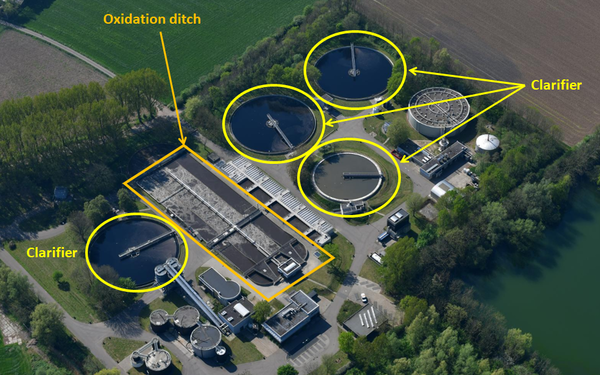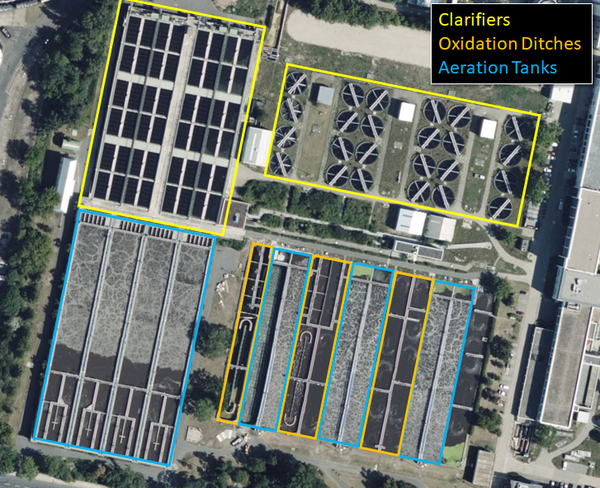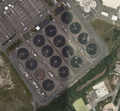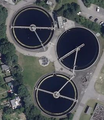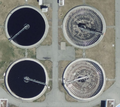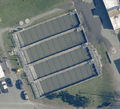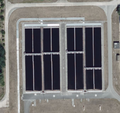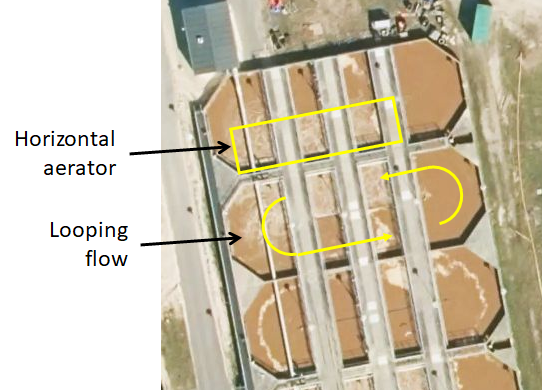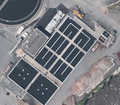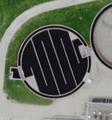Proposal:Process tanks
| Process tanks | |
|---|---|
| Proposal status: | Proposed (under way) |
| Proposed by: | |
| Tagging: | equipment=*
|
| Applies to: | |
| Definition: | Structures used for the processing of chemicals, feeds, wastewater, or other components |
| Statistics: |
|
| Draft started: | 2021-03-07 |
| RFC start: | 2021-03-20 |
Proposal
A process tank is a type of ![]() storage tank that is used for the processing of chemicals, feeds, wastewater, or other components, leading to the production of a desired substance or product.
storage tank that is used for the processing of chemicals, feeds, wastewater, or other components, leading to the production of a desired substance or product.
In water treatment facilities, ![]() aeration tanks,
aeration tanks, ![]() clarifiers and
clarifiers and ![]() oxidation ditches are specific types of process tanks used to separate sludge (which settles to the bottom) and scum (which floats to the top) from untreated or waste water. These structures are often found adjacent to each other in water treatment facilities, although not all water treatment facilities have all types of structures.
oxidation ditches are specific types of process tanks used to separate sludge (which settles to the bottom) and scum (which floats to the top) from untreated or waste water. These structures are often found adjacent to each other in water treatment facilities, although not all water treatment facilities have all types of structures.
Proposed are that:
- Process tanks of all types are tagged with the existing tag
man_made=storage_tankas the top-level tag - The tag
equipment=*is approved to tag the presence of processing equipment or infrastructure in a tank, with the following initial values: - The key
equipment:stage=*is approved to tag a process tank's stage in a processing chain.- The tags
equipment:stage=primaryandequipment:stage=secondaryare used to tag primary and secondary clarifiers.
- The tags
- It is recommended that process tanks associated with water treatment (for example, clarifiers, oxidation ditches, and aeration tanks) should not be tagged
natural=water,water=wastewaterorlanduse=basin, but rather should be taggedman_made=storage_tank, and where applicable,equipment=*. - The current use of
water=wastewaterto tag wastewater ponds and basins remains unchanged. - The tags
man_made=wastewater_basinandman_made=sewageare deprecated.
While this proposal proposes specific tagging for features associated with water treatment plant, equipment=* and equipment:stage=* are generic tags that can be used and/or extended for any industry.
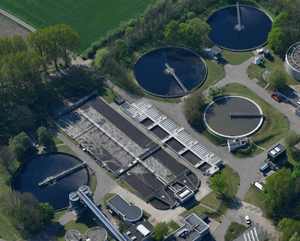
Summary of tagging changes
| Tag | Action | Description |
|---|---|---|
man_made=storage_tank
|
Expand Definition | Update wiki definition to include storage tanks that also contain processing equipment. |
equipment=aerator
|
Approve | Used to tag an |
equipment=clarifier
|
Approve | Used to tag a |
| TBD | Used to indicate whether a clarifier (tagged man_made=storage_tank + equipment=clarifier) is a primary or secondary clarifier.
| |
equipment=oxidation_ditch
|
Approve | Used to tag an |
equipment=baffles
|
Approve | Used to tag process tanks which contains |
| Deprecate | These tags have little usage and are wholly described by other tagging. |
Rationale
- Clarifiers, oxidation ditches, and aeration tanks are large constructed features, usually with steel and/or concrete housing. Therefore, it is not appropriate to categorize these features as basins, which are of earthen construction. Similarly, it is not appropriate to categorize these features as a general water feature (
natural=water), as these are industrial structures which may contain sewage, waste water, or untreated reservoir water. - Discussion on the proposal for tailings ponds indicated that people felt that tailings should not be categorized as water, even though tailings are mostly water. Similarly, sewage, waste water, and sludge, should not be classified as water. The tagging
natural=water+water=wastewatercauses sewage and waste water to be grouped in with traditional waterbodies such as lakes, ponds, and reservoirs. By providing specific tagging for wastewater processing tanks, we reduce the usage ofnatural=wateron non-water industrial processing features. - The tags
water=wastewaterandreservoir_type=sewageare used on water treatment features other than process tanks, such as settling ponds. Therefore, it is not proposed to deprecate these tags. However, this question may be addressed in a future proposal. - Due to the lack of approved, dedicated tagging for these features, they are often tagged as
natural=water,landuse=basin, orbuilding=yesin order to achieve rendering. By creating dedicated tagging scheme for these features, we create a clear path to uniformity in both tagging and rendering for these features. Sinceman_made=storage_tankcurrently renders in many styles, mappers can adopt this tagging and achieve render support without change to renderers. - The tag
water=wastewaterconflates clarifiers and oxidation ditches with settling basins. However, these are entirely different features. - The proposed key
equipment=*is unused for other purposes and provides a clear path to defining additional values which represent various types of processing equipment suitable for many industries. - Primary and secondary clarifiers are tagged in the map today, by mappers with specific domain knowledge of water treatment facilities, using a variety of invented tags. The proposed key
equipment:stage=*provides a uniform scheme for this tagging. - The tags
man_made=wastewater_basinandman_made=sewageare barely used and have unclear and redundant meaning, therefore they are proposed for deprecation.
How to map
Draw as an area ![]() along the outline of the tank.
along the outline of the tank.
Tag it with man_made=storage_tank.
Add the tag equipment=* if this is known.
Tagging
Clarifiers, oxidation ditches, aeration tanks, and baffled tanks are visually distinct and easily identified on imagery, as show in in the examples section. Draw a way on the outline of the structure, and tag as follows from the table below. For conjoined adjacent tanks, it is acceptable to tag the entire combined tank with a single polygon. If the mapper cannot identify the specific type of process tank, it is acceptable to tag it man_made=storage_tank without additional tagging.
The specific types of process tanks described in this proposal are easily identified on overhead imagery, and are usually open on top. In cases where a feature identified on imagery is ambiguous between a tank or a building, mappers may only make an educated guess based on the surrounding context or other external information, or else leave these objects to be mapped by a future mapper with more information.
| Tag | Description |
|---|---|
| Used as to tag an aeration tank | |
|
OR |
Used as to tag an aeration pond or basin[1] |
| Used to tag a primary clarifier. The information on whether a clarifier is primary or secondary likely requires addition information about the facility that cannot be determined from overhead imagery alone. | |
| Used to tag an oxidation ditch | |
| Used to tag a baffled tank. In water treatment plants, baffled process tanks are sometimes used when disinfecting chemicals are added to treated water. In open tanks, the baffles are typically visible as either a labyrinth pattern or as axial protrusions from the wall of a circular chamber. Photos of baffled tanks are provided in the examples section. |
Examples
The following image from the Rioolwaterzuiveringsinstallatie Nieuwegein![]() Rioolwaterzuiveringsinstallatie Nieuwegein in the Netherlands shows examples of both clarifiers and oxidation ditches.
Rioolwaterzuiveringsinstallatie Nieuwegein in the Netherlands shows examples of both clarifiers and oxidation ditches.
This image from the Klärwerk Ruhleben![]() Klärwerk Ruhleben treatment plant near Berlin, Germany, shows examples of aeration tanks, both circular and rectangular clarifiers, and oxidation ditches.
Klärwerk Ruhleben treatment plant near Berlin, Germany, shows examples of aeration tanks, both circular and rectangular clarifiers, and oxidation ditches.
Aeration Tanks
Aeration tanks are used to treat wastewater by introducing air into wastewater. These tanks are identifiable by the presence of turbulent water in the tank. However, unlike oxidation ditches, the water does not circulate in a loop.
Examples:
-
Large aeration tanks at the Stickney Water Reclamation Plant
 Stickney Water Reclamation Plant, Chicago, USA
Stickney Water Reclamation Plant, Chicago, USA -
Aeration tank at the Town of Smithfield Wastewater Treatment Plant
 Town of Smithfield Wastewater Treatment Plant, Rhode Island, USA
Town of Smithfield Wastewater Treatment Plant, Rhode Island, USA
Clarifiers
The purpose of a clarifier is to mechanically separate both scum and sludge from wastewater. Clarifiers are recognizable by their mechanical skimming arm. Below are examples of clarifiers from water treatment plants. There are two basic designs:
Circular clarifiers use a radial skimming arm which turns around a central axis. A trough around the edge of the clarifier catches the scum trapped by the arm.
Examples:
-
Clarifiers at the ETE Alegria
 ETE Alegria treatment plant, Rio de Janeiro, Brazil
ETE Alegria treatment plant, Rio de Janeiro, Brazil -
Clarifiers at the Cape Flats Waste Water Treatment Works
 Cape Flats Waste Water Treatment Works, Cape Town, South Africa
Cape Flats Waste Water Treatment Works, Cape Town, South Africa -
Clarifiers at the MCUA Central Treatment Facility
 MCUA Central Treatment Facility, New Jersey, USA
MCUA Central Treatment Facility, New Jersey, USA -
Clarifiers at the Kläranlage Porz Wahn
 Kläranlage Porz Wahn, Germany
Kläranlage Porz Wahn, Germany -
In use and empty clarifiers at Wassmannsdorf Sewage Plant
 Wassmannsdorf Sewage Plant, Germany
Wassmannsdorf Sewage Plant, Germany
Rectangular clarifiers use a series of parallel skimming arms which move from one end of the clarifier to the other, with a scum trough on one end. Note in the example photos that the skimming arms of adjacent clarifiers are slightly offset from each other -- this is a visual indication that these are clarifiers since the sets of skimming arms in each tank typically are driven independently and will not be in sync.
Examples:
-
Rectangular clarifiers at the East Providence Wastewater Treatment Facility
 East Providence Wastewater Treatment Facility, Rhode Island, USA
East Providence Wastewater Treatment Facility, Rhode Island, USA -
Rectangular clarifiers at a Sewage treatment plant
 Sewage treatment plant, Vienna, Austria
Sewage treatment plant, Vienna, Austria -
Regangular clarifiers with a single skimming arm at Klärwerk Münchhofe
 Klärwerk Münchhofe, Germany
Klärwerk Münchhofe, Germany
Oxidation ditches
Oxidation ditches are found in round or oval configurations which allow the liquid to flow in a loop. A portion of the loop is turbid, as this is where the aerator machinery is introducing aeration to the water. The key identifying characteristics of an oxidation ditch are the round or oval shape, and the visible trails from horizontal aerators as the liquid flows around the loop. In some cases, the oxidation ditches will be rectangular in shape, but with semi-circular guides at each end to direct the liquid in a looping flow.
Below are examples of oxidation ditches:
-
Oxidation ditches at the Renseanlæg Damhusåen
 Renseanlæg Damhusåen treatment plant, Denmark
Renseanlæg Damhusåen treatment plant, Denmark -
Oxidation ditches at the Люберецкая станция аэрации
 Люберецкая станция аэрации treatment plant in Moscow, Russia. Note the semi-circular guides at each end
Люберецкая станция аэрации treatment plant in Moscow, Russia. Note the semi-circular guides at each end -
Oxidation ditches at the RWZI - Veenendaal
 RWZI - Veenendaal treatment plant in The Netherlands with oval shape and semi-circular guides
RWZI - Veenendaal treatment plant in The Netherlands with oval shape and semi-circular guides -
Circular oxidation ditches at a water treatment plant in Illinois, USA
 water treatment plant in Illinois, USA
water treatment plant in Illinois, USA
Baffled tanks
Baffled tanks are found in water treatment facilities and can be identified by their geometric baffle walls. These tanks are sometimes known as contact chambers, and are used to slow the movement of liquid through the tank. They can be found in various shapes.
Below are examples of baffled tanks:
-
Contact chamber at the Florham Park
 Florham Park treatment plant, New Jersey, USA
Florham Park treatment plant, New Jersey, USA -
Contact chamber at the Delcora Wastewater Treatment Plant
 Delcora Wastewater Treatment Plant, Pennsylvania, USA
Delcora Wastewater Treatment Plant, Pennsylvania, USA -
Irregularly-shaped Contact chamber at the Athlone Waste Water Treatment Works
 Athlone Waste Water Treatment Works, South Africa
Athlone Waste Water Treatment Works, South Africa -
Contact chambers at Пречиствателна станция за отпадни води
 Пречиствателна станция за отпадни води, Bulgaria
Пречиствателна станция за отпадни води, Bulgaria -
Circular baffled tank at the Greater Mentor Wastewater Treatment Plant
 Greater Mentor Wastewater Treatment Plant, Ohio, USA
Greater Mentor Wastewater Treatment Plant, Ohio, USA
Features/Pages affected
Create these pages:
equipment=*equipment=aeratorequipment=bafflesequipment=clarifierequipment=oxidation_ditchequipment:stage=*
Update the following pages consistent with this proposal:
External discussions
- March 2021, tagging: Strategy for tagging of water treatment and sewage features
Comments
Please comment on the discussion page.
- ↑ Note that aeration basins, which are earthen structures which have aeration equipment installed, should not be tagged as a tanks, but rather as a basin.
